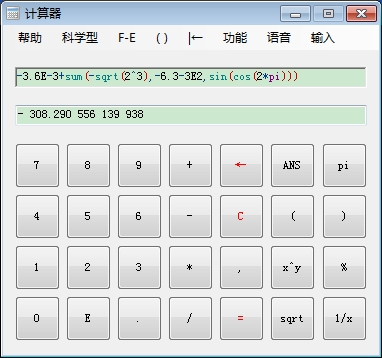一、前言
关于表达式计算器的实现,在这里分享一下我的思路,也希望大家提出一些改进建议。
二、实现表达式计算的主要思路。
1、使用的数据结构。
以前的版本实现表达式计算用的是二叉树数据结构,二叉树有两个子节点,最多支持双目运算符或者带两个参数的函数,可是如果函数的参数很多,就不好处理了,所以当前的版本,用的数据结构是动态数组,实现原理就是先把字符串表达式转换成动态数组,数组中存储运算符、参与运算的数、括号等。这样运算符或者函数的参数个数就不受限制,可以支持更多类型的运算符。
2、对运算符进行分类。
对运算符的分类处理是该程序的一个重要思路,运算符虽然有很多,但是可以将运算符归类,针对每一类运算符分别处理,这样核心算法就不会涉及到具体的运算符,只会涉及到运算符的类别。这样以后如果要扩展更多的运算符就会很方便,不需要再修改核心算法的代码,只需要修改运算符集合类就可以了。

/// <summary> /// 运算符类型 </summary> enum OpeType { <summary> 该运算因子不是运算符 </summary> notOperator, 常数或变量(没有参数的运算符) noparameter,1)"> '+'或'-' 这两个运算符即可以当正负号使用又可以当加减运算符使用 PlusOrMinus,1)"> 参数全在左边的运算符 left,1)"> 参数全在右边的运算符 right,1)"> 左边和右边都有参数的运算符 bothSides,1)"> 左括号 leftParenthesis,1)"> 右括号 rightParenthesis,1)"> 分隔符,这里指逗号 Separator }
3、对表达式的进行合法性检查的思路。
对表达式的合法性检查,我没有学过编译原理,不懂什么是文法分析、词法分析。这个程序检查表达式的合法性的原理是:针对每一类运算符,分别进行判断,检查其参数的个数,参数是在右边还是在左边等等,主要代码如下:

#region 第四次处理 //第四次处理,判断表达式是否合法,并在合适的地方插入乘号 for (int i = 0; i < valList.Count - 1; i++) { #region 当前运算因子是数字 if (valList[i].type == ValType.Number)数字 { if (valList[i + 1].type == ValType.Operator)右边是运算符 { switch (valList[i + 1].OpeType) { case OpeType.bothSides:正确 break; case OpeType.left:case OpeType.leftParenthesis: Insert(opeList.Getope("*"),i + ); OpeType.noparameter: Insert(opeList.Getope(case OpeType.PlusOrMinus: OpeType.right: Insert(opeList.Getope(case OpeType.rightParenthesis:case OpeType.Separator:; } } else右边是数字 { Insert(opeList.Getope(); } } #endregion #region 当前运算因子是运算符 if (valList[i].type == ValType.Operator)运算符 #region 当前运算符右边是运算符 switch (valList[i].OpeType)左运算符 { #region case OpeType.bothSides:左运算符参数信息 左运算符参数信息 1].OpeType)右运算符 { OpeType.bothSides: MakeException(i); ; OpeType.left: MakeException(i); case OpeType.leftParenthesis:正确 case OpeType.noparameter: OpeType.PlusOrMinus: MakeException(i); case OpeType.right: OpeType.rightParenthesis: MakeException(i); OpeType.Separator: MakeException(i); ; } #endregion #region case OpeType.left: OpeType.leftParenthesis: Insert(opeList.Getope(); OpeType.noparameter: Insert(opeList.Getope( OpeType.right: Insert(opeList.Getope(case OpeType.Separator: #region case OpeType.leftParenthesis: OpeType.bothSides: int pos = i + 1 >= 0 ? i + : i; MakeException(pos); OpeType.left: pos = i + OpeType.rightParenthesis: pos = i - 0 ? i - OpeType.Separator: pos = i - #region case OpeType.noparameter:#region case OpeType.PlusOrMinus:#region case OpeType.right: OpeType.noparameter: MakeException(i); OpeType.right: MakeException(i); #region case OpeType.rightParenthesis:#region case OpeType.Separator: OpeType.bothSides: MakeException(i + OpeType.left: MakeException(i + #endregion } } #endregion #region 当前运算符右边是数字 else 1].type == ValType.Number)运算符右边是数字 switch (valList[i].OpeType) { OpeType.left: Insert(opeList.Getope( OpeType.right: MakeException(i); OpeType.rightParenthesis: Insert(opeList.Getope( } } #endregion
三、下面是表达式计算过程的主要步骤:
1、将字符串表达式中的数字、运算符、括号、逗号等提取出来,按顺序存储在一个动态数组中。
原理很简单,就是通过字符串搜索来实现,扫描字符串表达式,依次把运算符取出来放到动态数组中,运算符之间的内容就是参与运算的数了。
把字符串表达式转换成运算符、括号、逗号和数字的动态数组后,后面将处理这个数组,完成运算。
部分代码如下:

#region 将字符串表达式转换成运算因子(数字、常数及运算符)列表 将字符串表达式转换成运算因子列表 </summary> <param name="str">字符串表达式</param> private void ToList(List<CalVal> valList,string str) { do { 字符串中首个运算符的位置 int opePos = GetopePos(str); CalNum num = null; CalOpe ope = ; if (opePos > 0)找到运算符且它前面有数字 { num = GetNum(ref str,opePos); } if (opePos == 找到运算符且它在字符串最前面 { ope = Getope( str); } 没有找到运算符 str); } if (num != ) { valList.Add(new CalVal(num)); } if (ope != CalVal(ope)); } } while (str != ""); } #endregion #region 获取字符串中首个运算符或常数的位置 获取字符串中首个运算符或常数的位置 字符串</param> <returns>值若为-1表示未找到</returns> int GetopePos( str) { CalOpeList opeList = CalOpeList(); int pos = -; 0; i < opeList.count; i++int k = -int opeIndex = str.IndexOf(opeList.opeList[i].tag); 科学计数法的情况:如果'+'或'-'的前面是'E' if (opeList.opeList[i].opeType == OpeType.PlusOrMinus && opeIndex - 0 && str.Substring(opeIndex - 1,1) == E") { 从'+'或'-'的后面重新查找 k = str.Substring(opeIndex + ).IndexOf(opeList.opeList[i].tag); if (k != -1)如果找到 计算该运算符的位置 k += opeIndex + ; } } { k = opeIndex; } if (pos == -) { pos = k; } if (k >= 0 && k < pos) { pos = k; } } return pos;值若为-1表示未找到 } #region 获得运算符 获得运算符 </summary> private CalOpe Getope(ref CalOpeList(); CalOpe ope = ; if (str.IndexOf(opeList.opeList[i].tag) == 0) { ope = opeList.opeList[i]; 更新str str = str.Substring(opeList.opeList[i].tag.Length); ; } } return ope; } #region 获取数字 获取数字 private CalNum GetNum(string str,1)">int opePos) { CalNum result = ; result = new CalNum(str.Substring(,opePos)); 更新str str = str.Substring(opePos); result; } str) { CalNum result = CalNum(str); 更新str str = result; } #endregion
2、优先级的处理。
优先级的处理是表达式计算过程中的一个关键问题。
动态数组中的每个元素(运算符、分隔符或数字等)都有一个优先级,对存储表达式的动态数组从前往后扫描,遇到左括号,将运算符的优先级提升,遇到右括号的话,将运算符的优先级降低。这样处理过后,动态数组中的运算符的优先级各不相同,括号中的运算符的优先级就会高于括号外的运算符的优先级。比如括号外的加号的优先级低于括号内的加号的优先级,因为在处理的过程中把括号内的加号的优先级提升了。

优先级处理,提高括号中的算式的运算符的优先级 void LevelProcess() { int delLevel = 0;优先级增量 0; i < valList.Count; i++if (valList[i].type == ValType.Operator) { 如果是左括号 if (valList[i].OpeType == OpeType.leftParenthesis) { delLevel += 1000; continue; } 如果是右括号 OpeType.rightParenthesis) { delLevel -= ; } valList[i].level = valList[i].ope.level + delLevel; } } }
3、在计算存储在动态数组中的表达式前,先生成优先级列表,并按优先级从高到低排好序。

#region 生成优先级列表 生成优先级列表 MakeLevelList() { #region 生成优先级列表,优先级按从高到低存储 逐个扫描运算因子,提取优先级列表,并按优先级从高到低存储 如果是运算符 如果是括号或分隔符 OpeType.leftParenthesis || valList[i].OpeType == OpeType.rightParenthesis || valList[i].OpeType == OpeType.Separator) { ; } InsertIntoLevelList( levelList,valList[i].level); } } } #endregion #region 将优先级插入到优先级列表中 将优先级插入到优先级列表中 <param name="levelList">优先级列表<param name="level">要插入的优先级void InsertIntoLevelList(ref List<int> levelList,1)"> level) { 列表为空的情况 if (levelList.Count == ) { levelList.Add(level); ; } 该优先级是否已存在 0; i < levelList.Count; i++该优先级已存在 if (level == levelList[i]) { int k = for (; k < levelList.Count; k++if (level > levelList[k]) { levelList.Insert(k,level); ; } } if (k >= levelList.Count) { levelList.Add(level); } } #endregion
4、遍历优先级列表,按照优先级从高到低,扫描表达式动态数组,先计算优先级高的运算,用计算结果替换掉计算之前的运算符和参与运算的数。当把优先级列表中的优先级都处理完,对表达式的计算也就结束了,这时,表达式动态数组中将只剩下计算结果。
下面是计算过程的主要代码:

#region 核心算法,对于当前优先级,扫描运算因子列表并计算 if (levelList.Count != 优先级列表不为空 #region 处理当前优先级 对于当前优先级,逐个扫描运算因子,处理具有该优先级的运算 ) { 找到具有该优先级的运算符 ValType.Operator && valList[i].level == levelList[0])该运算因子的优先级等于当前优先级 bool isSign = false;Sign为true表示当前运算因子是正负号 currentPos = valList[i].primalPos;记录当前运算因子在列表中的原始位置 参数列表 List<CalNum> numList = new List<CalNum>(); 临时计算结果 CalNum num; i表示该运算因子的位置 { #region case OpeType.PlusOrMinus: OpeType.PlusOrMinus: 若该运算符前面没有运算因子 或前一个运算因子是运算符,则按正负号计算 if (i == 0 || (i - 0 && valList[i - 1].type == ValType.Operator)) { isSign = true;是正负号 获取该运算符的参数 if (i + 1 < valList.Count && valList[i + ValType.Number) { 注意,下面第一句不可省略 numList = (); numList.Add(valList[i + ].num); } 计算 num = CalOpeList.Calculate(valList[i].ope,numList); 更新运算因子列表 ReplaceVal(num,1)">2i无需调整 } 若前一个运算因子是操作数,则按加减号计算 { if (valList[i - ValType.Number && i + (); numList.Add(valList[i - ].num); numList.Add(valList[i + 3,i - 调整i i--; } ; #endregion #region case OpeType.bothSides: OpeType.bothSides: 获取该运算符的参数 if (i >= 1 && valList[i - ValType.Number && i + ValType.Number) { 注意,下面第一句不可省略 numList = (); numList.Add(valList[i - ].num); numList.Add(valList[i + ].num); } 计算 num =更新运算因子列表 ReplaceVal(num,1)">); 调整i i--#region case OpeType.left: OpeType.left: 2,1)">#region case OpeType.noparameter: OpeType.noparameter: 注意,下面第一句不可省略 numList = (); #region case OpeType.right: OpeType.right: #region 该运算符只有一个参数,且它的右边是常数 1 < valList.Count && valList[i].ParameterNumber == 1 && valList[i + 获取该运算符的参数 (); numList.Add(valList[i + ].num); #endregion #region 该运算符不是只有一个参数,或者它的右边不是常数 { 计算参数个数 int count = ; int k = i + ; 从运算符后面开始检测 如果是左括号、分隔符或数字,则执行while中语句 while (k < valList.Count && (valList[k].type == ValType.Number || valList[k].OpeType == OpeType.Separator || valList[k].OpeType == OpeType.leftParenthesis)) { 如果是数字,参数个数加1 if (valList[k].type == ValType.Number) { count++; } k++; } (); 从该运算符后面,逐个扫描,获取该运算符的参数 j表示已读取的参数个数 m表示检测位置增量 int m = int j = 0; j < count; ) { 如果找到数字,存为参数 if (valList[i + j + m + ValType.Number) { numList.Add(valList[i + j + m + ].num); j++; } 如果是分隔符或左括号,检测位置增量加1,表示跳过该运算因子,继续检测 1].OpeType == OpeType.Separator || valList[i + j + m + OpeType.leftParenthesis) { m++; } } 更新运算因子列表,count+m+2中的2表示运算符本身和右括号 ReplaceVal(num,count + m + ; }end switch if (!isSign)如果不是正负号 break;退出for循环 } } } #region 删除处理完的优先级 bool levelExists = 是否存在具有该优先级的运算符 逐个扫描运算因子,判断是否仍存在具有该优先级的运算符 if (levelList[0] == valList[i].level)存在 { levelExists = trueif (!levelExists)该优先级已处理完则删除它 { levelList.RemoveAt(); } #endregion
四、结束语。
没有什么高深的思想,我用最笨的办法实现了表达式计算。这个程序中用的最多的算法就是字符串查找,以及遍历数组。
程序截图:

GitHub地址:https://github.com/0611163/ScientificCalculator.git
源代码下载:http://pan.baidu.com/s/1jGyV45w
版权声明:本文内容由互联网用户自发贡献,该文观点与技术仅代表作者本人。本站仅提供信息存储空间服务,不拥有所有权,不承担相关法律责任。如发现本站有涉嫌侵权/违法违规的内容, 请发送邮件至 [email protected] 举报,一经查实,本站将立刻删除。




